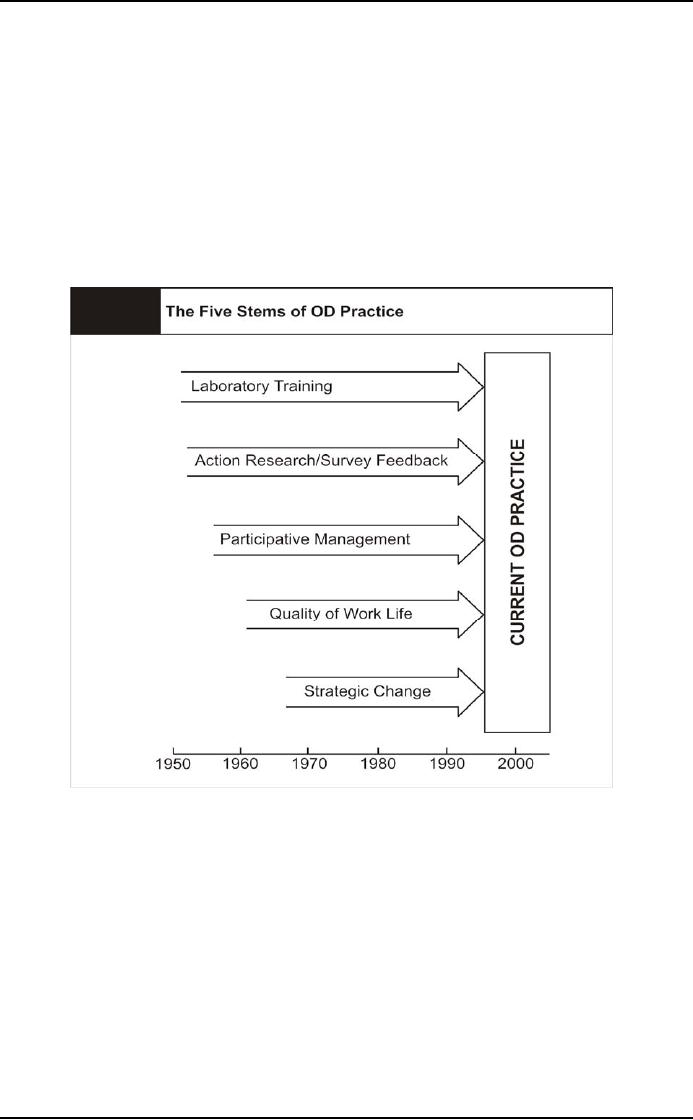 |

Organization
Development MGMT
628
VU
Lesson
04
The
Evolution of OD
A
brief history of OD will
help to clarify the evolution of the term
as well as some of the problems
and
confusion
that have surrounded it. As currently
practiced, OD emerged from
five major stems, as
shown
below.
The first was the growth of
the National Training Laboratories (NTL)
and the development of
training
groups, otherwise known as sensitivity
training or T-groups, The second
stem of OD was the
classic
work on action research conducted by
social scientists interested in
applying research to
managing
change.
An important feature of action research
was a technique known as
survey feedback. Kurt Lewin,
a
prolific
theorist, researcher, and practitioner in
group dynamics and social
change, was instrumental in the
development
of T-groups, survey feedback, and action
research. His work led to the creation of
OD and
still
serves as a major source of its
concepts and methods. The
third stem represents the
application of
participative
management to organization structure and
design. The fourth stem is
the approach focusing
on
productivity and the quality of
work life. The fifth
stem of OD, and the most
recent influence on
current
practice, involves strategic change
and organization transformation.
Figure:
03
1.
Laboratory
Training (The
T-Group):
This
stem of OD pioneered laboratory training,
or the T-group a small, unstructured
group in which
participants
learn from their own
interactions and evolving dynamics about
such issues as interpersonal
relations,
personal growth, leadership,
and group dynamics.
Essentially, laboratory training
began in 1946,
when
Kurt Lewin, (1898
1947, a prolific theorist, researcher,
and practitioner in interpersonal,
group,
intergroup,
and community relationships) widely recognized as the
founding father of OD,
although he
died
before the concept became current in the
mid-1950s, and his staff at the
Research Centre for
Group
Dynamics
at the Massachusetts Institute of
Technology (MIT) were asked
by the Connecticut Interracial
Commission
for help on research in
training community leaders. A workshop
was developed, and
the
community
leaders were brought together to
learn about leadership and
to discuss problems. At the end
of
each
day, the researchers discussed
privately what behaviors and
group dynamics they had
observed. The
community
leaders asked permission to
sit in on these feedback
sessions. Reluctant at first, the
researchers
finally
agreed. Thus, the first
T-group was formed in which
people reacted to data about
their own
behavior.
The researchers drew two
conclusions about the first T-group
experiment:
Feedback
about group interaction was
a rich learning experience,
and
The
process of "group building"
had potential for learning
that could be transferred to
"back-home"
situations.

Organization
Development MGMT
628
VU
As
a result of this experience, the Office
of Naval Research and the
National Education Association
provided
financial backing to form the National
Training Laboratories (NTL), and
Gould Academy in
Bethel,
Maine, was selected as a
site for further work
(since the, Bethel has
played an important part
in
NTL).
The first Basic Skill
Training Groups (later called
T-groups) were offered in
1947. The program was
so
successful that out of Bethel
experiences and NTL grew a significant
number of laboratory training
centers
sponsored by universities.
In
the 1950s, three trends
emerged:
The
emergence of regional
laboratories,
The
expansion of year-round sessions of T-groups,
and
The
expansion of the T-group into
business and industry, with
NTL members becoming
increasingly
involved
with industry programs.
Over
the next decade, as trainers
began to work with social
systems of more permanency
and complexity
then
T-groups, they began to experience
considerable frustration in the transfer
of laboratory behavioral
skills
and insights of individuals
into the solution of problems in
organizations. Personal skills
learned in
the
T-group settings were very
difficult to transfer to complex
organizations. However, the training
of
"teams"
from the same organization had
emerged early at Bethel and
undoubtedly was a link to the
total
organizational
focus of Douglas McGregor,
Herbert Shepard, and Robert
Blake, and subsequently
the
focus
of Richard Beckhard, Chris
Argyris, Jack Gibb, Warren
Bennis, and others. All
had been T-group
trainers
in NTL programs.
Applying
T-group techniques to organizations
gradually became known as
team building a process
for
helping
work groups become more
effective in accomplishing tasks and
satisfying member
needs.
2.
Action
Research/Survey Feedback:
Kurt
Lewin also was involved in
the second movement that led to OD's
emergence as a practical field
of
social
science. This second stem
refers to the processes of action
research and survey
feedback. The action
research
contribution began in the 1940s
with studies conducted by
social scientists John Collier,
Kurt
Lewin,
and William Whyte. They
discovered that research
needed to be closely linked to action
if
organization
members were to use it to
manage change. A collaborative effort
was initiated between
organization
members and social
scientists to collect research data about
an organization's functioning, to
analyze
it for causes of problems,
and to devise and implement solutions.
After implementation, further
data
were collected to assess the
results, and the cycle of
data collection and action
often continued. The
results
of action research were twofold:
members of organizations were
able to use research on
themselves
to
guide action and change, and
social scientists were able
to study that process to derive
new knowledge
that
could be used elsewhere.
Among
the pioneering action research studies
was the work of Lewin at a
Manufacturing Co.
(Harwood
Manufacturing
Company) and the classic
research by Lester Coch and
John French on overcoming
resistance
to change. The latter study
led to the development of participative management as a
means of
getting
employees involved in planning
and managing change. Other
notable action research
contributions
included
Whyte and Edith Hamilton's
famous study of Chicago's
Tremont Hotel and Collier's
efforts to
apply
action research techniques to improving
race relations when he was
commissioner of Indian
affairs
from
1933 to 1945. These studies
did much to establish action
research as integral to organization
change.
Today,
it is the backbone of most OD
applications.
A
key component of most action research
studies was the systematic
collection of survey data
that was fed
back
to the client organization. Following Lewin's
death in 1947, his Research
Center for Group
Dynamics
at
MIT moved to Michigan and joined
with the Survey Research
Center as part of the Institute
doe Social
Research.
The Institute was headed by
Renis Likert, a pioneer in developing scientific
approaches to
attitude
surveys. Likert's doctoral
dissertation at Columbia University, "A
Technique for the
Measurement
of
Attitudes," was the classic
study in which he developed the widely
used, five-point "Likert
Scale."
In
an early study by the institute,
Likert and Floyd Mann
administered a companywide survey
of
management
and employee attitudes at
Detroit Edison. Over a two-year period
beginning in 1948,
three
sets
of data were developed: (1)
the viewpoints of eight thousand non-supervisory
employees about their
supervisors,
promotion opportunities, and
work satisfaction with
fellow employees; (2)
similar reactions
from
first- and second-line
supervisors; and (3)
information from higher levels of
management.
The
feedback process that
evolved was an "interlocking
chain of conferences." The major
findings of the
survey
were first reported to the top
management and then transmitted
throughout the organization. The
feedback
sessions were conducted in
task groups, with
supervisors and their
immediate subordinates
discussing
the data together. Although there
was little substantial
research evidence, the
researchers
intuitively
felt that this was a
powerful process for
change.
In
1950, eight accounting departments
asked for a repeat of the
survey, thus generating a
new cycle of
feedback
meetings. In four departments,
feedback approaches were
used, but the method varied, with
two

Organization
Development MGMT
628
VU
of
the remaining departments receiving
feedback only at the departmental level.
Because of changes in
key
personnel,
nothing was done in two
departments.
A
third follow-up study indicated
that more significant and
positive changes, such as
job satisfaction, had
occurred
in the departments receiving feedback
than in the two departments that
did not practice.
From
those
findings, Likert and Mann
derived several conclusions about the
effects of survey feedback
on
organization
change. This led to extensive applications of
survey-feedback methods in a variety of
settings.
The
common pattern of data collection, data
feedback, action planning, implementation,
and follow-up
data
collection in both action research
and survey feedback can be
seen in these
examples.
Part
of the emergence of survey research
and feedback was based on
the refinements made by SRC
(Survey
Research
Center of Michigan) staff members in
survey methodology. Another
part was the evolution
of
feedback
methodology.
Likert
Scale:
Likert
scale is
often used in questionnaires,
and is the most widely used
scale in survey research.
When
responding
to a Likert questionnaire item,
respondents specify their level of
agreement to a statement.
A
typical test item in a Likert scale is a
statement. The respondent is
asked to indicate his or her
degree of
agreement
with the statement or any
kind of subjective or objective evaluation of the
statement.
Traditionally
a five-point scale is used, however
many advocate using a seven
or nine point scale.
Ice
cream is good for
breakfast:
Strongly
disagree
o
Disagree
o
Neither
agree nor disagree
o
Agree
o
Strongly
agree
o
Scoring
and analysis:
After
the questionnaire is completed, each item
may be analyzed separately or item
responses may be
summed
to create a score for a
group of items.
Results
of Action Research/Survey
Feedback:
Likert,
along with some of his
colleagues, while doing a
company-wide study of employee
perceptions,
behavior,
reactions and attitudes found
that:
When
the survey data were reported to a
manager (or supervisor) and
he or she failed to discus the
results
with
subordinates and failed to
plan with them what the managers
and others should do to
bring
improvement,
little change
occurred.
On
the other hand, when the manager
discussed the results with
subordinates and planned with them
what
to
do to bring improvement, substantial favorable
changes occurred.
Another
aspect of the study was the
process of feeding back data
from an attitude survey to
the
participating
departments had more
positive change in business
organizations than that coming
from
traditional
training courses.
The
effectiveness of this method is that it
deals with the system of
human relationships as a whole
(supervisors
and subordinates can change
together) and it deals with
each manager, supervisor,
and
employee
in the context of his job,
his own position, and
his own work
relationship.
Table of Contents:
- The Challenge for Organizations:The Growth and Relevance of OD
- OD: A Unique Change Strategy:OD consultants utilize a behavioral science base
- What an “ideal” effective, healthy organization would look like?:
- The Evolution of OD:Laboratory Training, Likert Scale, Scoring and analysis,
- The Evolution of OD:Participative Management, Quality of Work Life, Strategic Change
- The Organization Culture:Adjustment to Cultural Norms, Psychological Contracts
- The Nature of Planned Change:Lewin’s Change Model, Case Example: British Airways
- Action Research Model:Termination of the OD Effort, Phases not Steps
- General Model of Planned Change:Entering and Contracting, Magnitude of Change
- The Organization Development Practitioner:External and Internal Practitioners
- Creating a Climate for Change:The Stabilizer Style, The Analyzer Style
- OD Practitioner Skills and Activities:Consultant’s Abilities, Marginality
- Professional Values:Professional Ethics, Ethical Dilemmas, Technical Ineptness
- Entering and Contracting:Clarifying the Organizational Issue, Selecting an OD Practitioner
- Diagnosing Organizations:The Process, The Performance Gap, The Interview Data
- Organization as Open Systems:Equifinality, Diagnosing Organizational Systems
- Diagnosing Organizations:Outputs, Alignment, Analysis
- Diagnosing Groups and Jobs:Design Components, Outputs
- Diagnosing Groups and Jobs:Design Components, Fits
- Collecting and Analyzing Diagnostic information:Methods for Collecting Data, Observations
- Collecting and Analyzing Diagnostic information:Sampling, The Analysis of Data
- Designing Interventions:Readiness for Change, Techno-structural Interventions
- Leading and Managing Change:Motivating Change, The Life Cycle of Resistance to Change
- Leading and managing change:Describing the Core Ideology, Commitment Planning
- Evaluating and Institutionalizing Organization Development Interventions:Measurement
- Evaluating and Institutionalizing Organization Development Interventions:Research Design
- Evaluating and Institutionalizing Organization Development Interventions
- Interpersonal and Group Process Approaches:Group Process
- Interpersonal and Group Process Approaches:Leadership and Authority, Group Interventions
- Interpersonal and Group Process Approaches:Third-Party Interventions
- Interpersonal and Group Process Approaches:Team Building, Team Building Process
- Interpersonal and Group Process Approaches:Team Management Styles
- Organization Process Approaches:Application Stages, Microcosm Groups
- Restructuring Organizations:Structural Design, Process-Based Structures
- Restructuring Organizations:Downsizing, Application Stages, Reengineering
- Employee Involvement:Parallel Structures, Multiple-level committees
- Employee Involvement:Quality Circles, Total Quality Management
- Work Design:The Engineering Approach, Individual Differences, Vertical Loading
- Performance Management:Goal Setting, Management by Objectives, Criticism of MBO
- Developing and Assisting Members:Career Stages, Career Planning, Job Pathing
- Developing and Assisting Members:Culture and Values, Employee Assistance Programs
- Organization and Environment Relationships:Environmental Dimensions, Administrative Responses
- Organization Transformation:Sharing the Vision, Three kinds of Interventions
- The Behavioral Approach:The Deep Assumptions Approach
- Seven Practices of Successful Organizations:Training, Sharing Information